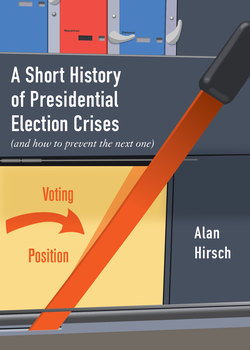Читать книгу A Short History of Presidential Election Crises - Alan Hirsch - Страница 8
На сайте Литреса книга снята с продажи.
ОглавлениеINTRODUCTION
While the Russian government engaged in covert operations in order to influence the 2016 United States presidential election, no evidence indicates any direct alteration of the vote tabulation—for example, converting votes for Hillary Clinton to votes for Donald Trump. But suppose someone does hack voting machines, and those efforts decide the outcome of the election. What mechanism in the Constitution enables us to reverse an illegitimate election?
You may be surprised to learn the answer: There is none. The U.S. Constitution provides no means for undoing an illegitimate presidential election. Article II sets forth procedures for electing the president, but does nothing to ensure the legitimacy of the outcome. In the more than two centuries since the Constitution was ratified, neither Congress nor the states have filled the void. Today, in the age of hacking, the continued failure to act would be stunningly shortsighted.
The problem transcends improper interference with an election. Outright cheating—the stuffing of ballot boxes, dead people voting, hacking, and other species of fraud—is not the only way an election can go awry. Even in a relatively honest competition, circumstances may render it difficult to determine the actual winner. Just ask Al Gore. The monthlong chaos and convoluted litigation that ensued in Florida after the votes were tallied in 2000 reflected the absence of a reliable procedure for resolving a disputed election.
To some extent, the 2000 nightmare stemmed from a perverse alignment of the stars, a series of circumstances that will never be replicated. (Among other things, the election came down to the state that happened to be governed by the brother of one of the candidates.) But it would be a mistake to think that only a fluke can create a presidential election crisis. The year 2000 was the fourth time—along with 1800, 1824, and 1876—that a presidential election left the nation with no clear winner and no reliable process for determining one. Many other elections (1880, 1888, 1916, 1960, 1968, 1976, 2004, and 2016) were sufficiently close that a malfunction or misfeasance in a few states could have affected the outcome. All told, in twelve presidential elections, more than 20 percent of all such contests, the result was too close for comfort.
This is no accident. Rather, it stems from America’s unusual method of picking a president. We often hear attacks on the Electoral College because of its undemocratic nature: Someone can become president despite receiving millions fewer votes than his or her opponent. Equally troubling aspects of the Electoral College, however, have gone overlooked, including its capacity to produce cliff-hanger elections. In addition, the Electoral College may have been introduced to reinforce white supremacy.
Our flawed method of choosing a president calls to mind Charles Dudley Warner’s quip about the weather: Everyone talks about it, but no one does anything about it. It is remarkable that, notwithstanding several crisis-ridden presidential elections, we have done little to remedy the underlying problems. In the aftermath of the first crisis election, in 1800, Congress did pass and the states then ratified the Twelfth Amendment to the Constitution, a partially successful effort to prevent a recurrence. The same cannot be said for the response to later disasters. No reforms followed the 1824 train wreck of an election. Fortunately, it took a half century before the nation experienced another dangerously uncertain presidential election. After the 1876 fiasco, in which the outcome was determined by a partisan commission and backroom dealing, we might have expected remedial action. Congress passed one relevant statute, but it was wholly inadequate. This time, though, the nation proved luckier. It took more than a century for another full-bore crisis. After the imbroglio in 2000, just as after the crisis-ridden elections of 1824 and 1876, little was done to prevent a recurrence.
That is not to say that our method of choosing a president has remained the same. In the nation’s early days, members of the Electoral College were selected by state legislatures. Today, virtually every state picks its electors through a statewide popular vote. The Twelfth Amendment enables the presidential and vice presidential candidates of each party to run as a unified ticket. The Fourteenth Amendment stipulates that any state that denies African Americans the vote will receive a reduced number of electoral votes, and the Twenty-Third Amendment gives the District of Columbia electoral votes. None of these changes, however, does anything to prevent the kinds of crises that have arisen on multiple occasions. We remain vulnerable to another crisis. Indeed, in the age of hacking, we are more vulnerable than ever.
This book is motivated by a combination of three circumstances. First, history teaches that we often experience razor-close presidential elections, which can and sometimes do produce crises. Second, our method of picking the president invites serious problems, and new circumstances have increased the risk. Third, we lack the means of resolving the next crisis, even though we have every reason to fear one.
The implicit premise of this book is the philosopher George Santayana’s oft-cited maxim that the failure to learn from history assures repeating its mistakes. With that in mind, the first five chapters revisit the controversial elections of 1800, 1824, 1876, 2000, and 2016. This journey tees up Chapters Six and Seven, which propose constitutional amendments designed to prevent recurrences. Chapter Six advocates an amendment that would reduce the likelihood of elections producing a crisis, and Chapter Seven proposes an amendment that would establish a rational procedure for resolving the crises that do arise.
